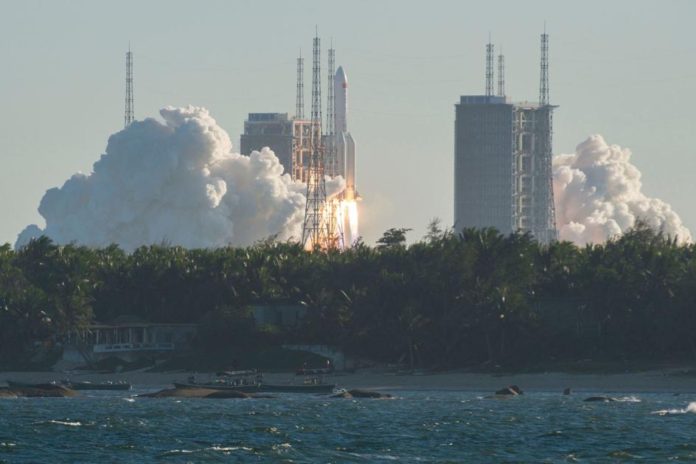A large, out-of-control piece of space debris crashed into the Atlantic Ocean yesterday, passing over much of the United States.
China launched the the Long March 5B rocket on May 5 from the Wenchang launch site in order to deploy a test model of its upcoming crew capsule. After a week in orbit, the nearly 18-metric-ton core stage re-entered the atmosphere and crashed into the Atlantic Ocean, becoming the largest piece of uncontrolled space debris to re-enter the atmosphere since 1991, as Harvard-Smithsonian Center for Astrophysics astronomer Jonathan McDowell noted on Twitter.
After the launch, the rocket began a week-long orbit. The U.S. military soon started tracking the rocket’s core stage. After a trajectory that took it over heavily populated areas such as New York and Los Angeles, the rocket hit the ocean off the coast of West Africa. Uncontrolled reentries and eventual crash sites are difficult to model, since scientists don’t fully understand the complex dynamics of the upper atmosphere, Holger Krag, head of ESA’s Space Debris Office, said in a 2018 statement. Such debris can travel vast distances in short stretches of time.
The 176-foot Long March 5B rocket is designed to bring large payloads, like components of China’s upcoming space station, into orbit. This mission deployed a prototype crew capsule that would be used to bring astronauts into orbit, as well as an experimental cargo return capsule, which malfunctioned as it returned into the atmosphere, reports Spaceflight Now.
See Also:- SpaceX, Blue Origin Will Supply NASA With Moon-Landing Equipment
This all might remind you of the 2018 uncontrolled reentry of the Chinese satellite Tiangong-1, a relatively small piece of space debris that crashed into the Pacific Ocean. The Tiangong-2 rocket reentered the atmosphere in the South Pacific as part of a controlled deorbiting last year.
But the Long March 5B core stage stands out in its size. While most of the rocket would have burned up in the atmosphere, some of the denser parts could potentially survive the descent and cause localized damage on the ground, McDowell told CNN.
The largest piece of space junk to re-enter Earth’s atmosphere was the Skylab space station in 1979; the larger Mir space station returned to the Earth as part of a controlled reentry in 2001.
Earth is really big and mostly water, so the odds of death-by-space-debris are exceedingly slim. Still, we’re launching more satellites all the time, so it’s something that space agencies are increasingly having to consider. Freak accidents do happen, though: In 1997, a woman in Oklahoma was struck (but nt injured) by a piece of metal from a disintegrating rocket.
See Also:- Virgin Galactic is partnering with NASA to develop supersonic point-to-point air travel










































